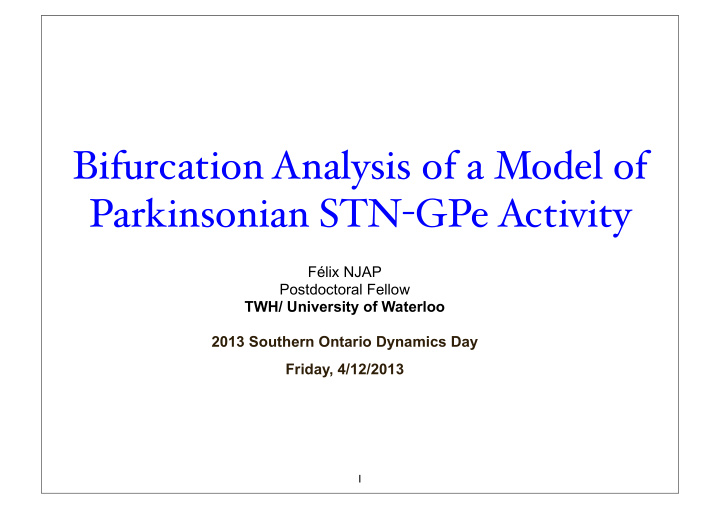



Bifurcation Analysis of a Model of Parkinsonian STN - GPe Activity Félix NJAP Postdoctoral Fellow TWH/ University of Waterloo 2013 Southern Ontario Dynamics Day Friday, 4/12/2013 1
Outline of the talk: Background and Related work Mathematical Modelling: Generic E/I network An Illustration : STN-GPe Model Results: Bifurcation Analysis Conclusion and discussions 2
Parkinson’s Disease ( PD ) Movement Disorder Tremor Muscle rigidity Loss of physical movement Basal Ganglia(BG) PD associated with: Loss of dopamine Changing in Firing patterns Neurons within BG: Increased synchronization Increased bursting activity 3
Oscillatory* Model ( Brown, 2003 ) Brown, 2003 BG activity may be synchronized in multiple frequency bands, each with different functional significance. Recording in patients withdrawn from their antiparkinsonian have consistently revealed prominent oscillations between 11 Hz and 30 Hz (Brown et al., 2001; Levy et al., 2000) The STN-GPe pacemaker circuitry may be important in generating synchronized oscillatory discharge in the BG (Plenz and Kitai, 1999) 4
Introduction Neural oscillations have been classified into different frequency bands delta, 1-3 Hz; theta, 4-7 Hz; alpha, 8-13 Hz; beta, 14-30 Hz; gamma, 30-80 Hz; fast, 80-200 Hz; ultra-fast, 200-600 Hz (Schnitzler and Gross, 2005); Beta (15-30Hz) oscillations in the basal ganglia are of interest as they may correlate with some symptoms of Parkinson’s disease (Kühn et al., 2006); Studying how these oscillations arise may help to understand and improve treatments. Previous modelling work suggests conditions for the STN-GPe network to produce oscillations (Gillies et al., 2002; Merrison et al., 2013); Bifurcation analysis gives a deeper understanding of how oscillations arise. The type of bifurcation line separating parameter regions shows how the system’s behaviour changes as it moves between oscillatory and steady-state regimes. 5
Generic Model: Two populations g ij : Connection strength from population i to j, P and Q represent the external input. An excitatory-Inhibitory network Mathematical Model ( Wilson and Cowan, 1972 ) Activation Function: The proportion of cells firing in a population for a given level of input activity 6
An Example: STN - GPe Model Contact: robert.merrison@plymouth.ac.uk Two equations: one for the excitatory STN and one for the inhibitory GPe (Wilson and Cowan, 1972) ' = − x S + Z S − w GS x G + w SS x S + I CS ( ) ( ) τ S x S 1 ' = − x G + Z G − w GG x G + w SG x s ( ) ( ) τ G x G 2 I CS : Constant input from the cortex to the STN “hyperdirect pathway” τ S , τ G : Typical membrane time constants. ( ) , z G . ( ) : Sigmoid Function. Z S . w IJ :Connection strength from population I to J. 7
Choice of Parameters The bifurcation of the system under variation of STN self- excitation (Wss) and cortical input (Ics) are studied. All connection strengths from (Holgado et al. 2010). Bifurcation analysis was done for “Healthy” and “Parkinsonian” cases Software Packages XPP : studying phase portrait LOCBIF, AUTO : Numerical continuation for computing bifurcation diagrams NumPy, XPPy : Visualising the variation of oscillation frequency parameters. 8
Bifurcation Diagram Parkinsonian State Region of system behaviour in parameter space under PD case 1. Region A: All initial conditions of the system will lead steady state activity. 2. A blue line shows a supercritical (A-H) bifurcation. As the parameters pass through this line the stable fixed point becomes unstable; A stable limit cycle appears around it. This corresponds to oscillatory activity. 3. All trajectories in region C tend to this limit cycle 4. Near the A-H bifurcation, the amplitude of oscillations is low and rapidly increases as parameters move away from it. 9
Bifurcation Diagram ( cont. ) Zooming the bifurcation diagram reveals more details around the cusp point. In particular, there is a homoclinic bifurcation. A small additional oscillatory region can be observed. None of the other regions contain oscillations. 10
Phase Portraits 11
E ff ects of Slowly increasing STN Self - Excitation http://dl.dropboxusercontent.com/u/14710806/ IsolatedChanMovie.mp4 Credit Video: Robert Merrison, Plymouth University 12
Oscillations in β - band Examining the variation of frequency with parameters in region C shows oscillations mostly in the beta band. 13
Periodic Input Using Parkinsonian parameters that give β oscillations, the effect of a 130Hz sinusoidal external input to the STN can be investigated. For weak input the power spectrum and phase portrait are unchanged. 14
Periodic Input For strong input the system is entrained to the input frequency. 15
Periodic Input For an intermediate range of magnitudes the limit cycle becomes a complex shape and the power spectrum is flattened 16
Amplitude of oscillations Near the A-H bifurcation, the amplitude of oscillations is low and rapidly increases as parameters move away from it. As the parameters move closer to the fold bifurcation at the top of region C the period of oscillation tends to ∞ Healthy State “Healthy” connection strengths do not give any parameters region with stable oscillations 17
Take Home Message Under “Parkinsonian” conditions the model is able to produce β oscillations. The frequency and amplitude of these oscillations are modulated by cortical input to the STN. Bifurcation analysis shows how the variation of parameters controls oscillations. High-frequency periodic input to the STN can flatten the power spectrum of oscillations. This may reflect the action of deep-brain stimulation. STN self-excitation is required for oscillations. Experimental data suggests that such connections are unlikely. A new hypothesis for how oscillations arise should be formulated and tested. Initial work suggests that adding additional populations can give stable oscillations without STN self-excitation. 18
Acknowledgements University of Plymouth University of Waterloo/UHN Prof. Roman Borisyuk Prof. Ann Sue Campbell Robert Merrison (PhD Candidate) Dr. Frances Skinner University of Lübeck Prof. Dr.rer.nat. Ulrich G. Hofmann (PhD supervisor) Fundings: German Excellence Initiative: Deutsche [Forschungsgemeinschaft DFG-GSC 235/1] 19
Recommend
More recommend